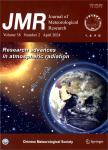Assessing Hourly Precipitation Forecast Skill with the Fractions Skill Score
Assessing Hourly Precipitation Forecast Skill with the Fractions Skill Score作者机构:National Meteorological Center Beijing 100081 China Meteorological Administration Numerical Weather Prediction Center Beijing 100081
出 版 物:《Journal of Meteorological Research》 (气象学报(英文版))
年 卷 期:2018年第32卷第1期
页 面:135-145页
核心收录:
学科分类:07[理学] 070601[理学-气象学] 0706[理学-大气科学]
基 金:Supported by the National Key Research and Development Program(2017YFA0604500) China Meteorological Administration Special Public Welfare Research Fund(GYHY201506002) China Meteorological Administration Special Project for Forecasters(YBGJXM(2017)06) National Natural Science Foundation of China(41305091)
主 题:neighborhood spatial verification method fractions skill score traditional category score hourly precipitation heavy rainfall
摘 要:Statistical methods for category(yes/no) forecasts, such as the Threat Score, are typically used in the verification of precipitation forecasts. However, these standard methods are affected by the so-called "double-penalty" problem caused by slight displacements in either space or time with respect to the observations. Spatial techniques have recently been developed to help solve this problem. The fractions skill score(FSS), a neighborhood spatial verification method, directly compares the fractional coverage of events in windows surrounding the observations and *** applied the FSS to hourly precipitation verification by taking hourly forecast products from the GRAPES(Global/Regional Assimilation Prediction System) regional model and quantitative precipitation estimation products from the National Meteorological Information Center of China during July and August 2016, and investigated the difference between these results and those obtained with the traditional category score. We found that the model spin-up period affected the assessment of stability. Systematic errors had an insignificant role in the fraction Brier score and could be ignored. The dispersion of observations followed a diurnal cycle and the standard deviation of the forecast had a similar pattern to the reference maximum of the fraction Brier score. The coefficient of the forecasts and the observations is similar to the FSS; that is, the FSS may be a useful index that can be used to indicate *** with the traditional skill score, the FSS has obvious advantages in distinguishing differences in precipitation time series, especially in the assessment of heavy rainfall.



